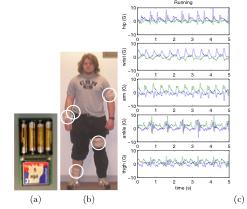January 25, 2005
Activity Recognition From User-Annotated Acceleration Data

|
This paper from Pervasive 2004 talked about collecting data from a bunch of worn wireless biaxial accelerometers and then using that data to determine what activities the user is engaged in. A key feature of this study was the semi-naturalistic data collection technique. Data was collected in two ways. One as an obstacle course and a second as an explicit description of the activity to undertake. The real strength of their data collection didn't seem to be that they were open ended about allowing the users to accomplish activities in a particular way, but rather that they had non-researchers undertaking the activities without supervision. |
The data was then analyzed with four standard machine learning techniques. The best performing technique was decision trees. The features were related to energy of the accelerometers in the frequency domain. Additional features included correlations between different accelerometers.
Overall this was a clear, cleanly executed paper that did an excellent job of addressing many methodology questions related to data acquisition. From a technical standpoint they showed that two accelerometers, one on the dominant wrist and one on the hip were sufficient to recognize most of their chosen activities. The system worked, was wireless and clearly evaluated.
I felt that the paper was weak in that it wasn't motivated strongly enough by an application. It's hard to say whether the activities that they picked were good ones or not, and therefore whether the accuracy rates were good enough because I couldn't nail down why we wanted to know about these activities. Maybe they were just activities that were easy to identify with accelerometers?
Posted by djp3 at January 25, 2005 1:07 PM | TrackBack (0)
